It’s easier to crack the College Football Playoff code than sort out the greatest national championship teams of the modern era, but let’s give it the old college try.
First, a few ground rules.
We don’t know anyone who was around in November 1869, when Rutgers and New Jersey (later Princeton) butted heads in the first college football game ever. So only teams from the post-war era are eligible.
Schools get capped at two entries each to allow for a more diverse field. Our apologies, Alabama and Notre Dame.
Also, there is a limit of one team per decade. Maybe next time, 1975 Oklahoma, 1986 Penn State and 1999 Florida State.
Whoa, Nellie, we’re gonna have some pretty good arguments here.
Honorable Mention: 1980 Georgia Bulldogs
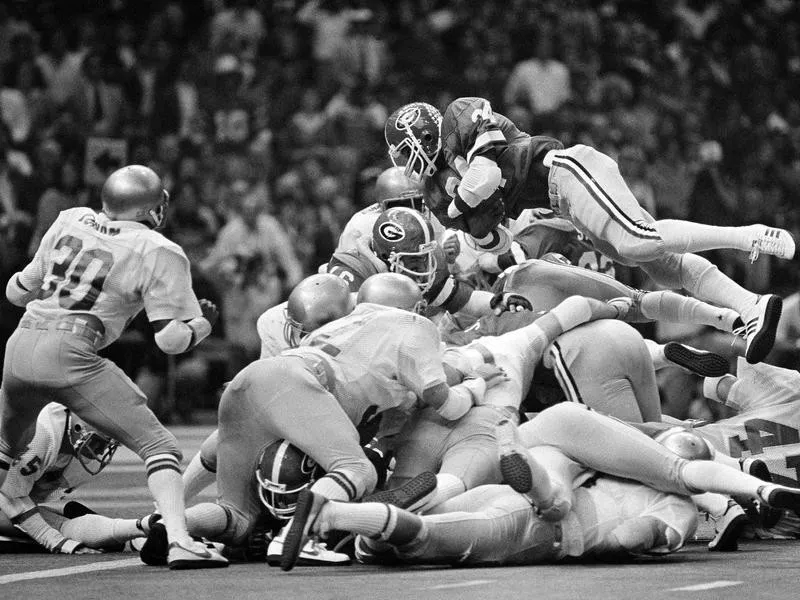
Georgia’s Herschel Walker leaps over Notre Dame’s defense to score a touchdown in the 1981 Sugar Bowl. Jack Thornell / AP Photo
Record: 12-0
Finish: Beat No. 7 Notre Dame 17-10 in the Sugar Bowl
Final ranking: No. 1 (Associated Press, Football Writers Association of America, National Football Foundation, United Press International polls)
Key stats: Tailback Herschel Walker had one of the greatest freshman seasons ever. He rushed for 1,616 yards and scored 15 touchdowns with an offense that ran the ball 78 percent of the time.
Head coach: Vince Dooley
Notable players: Walker, defensive linemen Jimmy Payne, wide receiver Lindsay Scott, safety/kick returner Scott Woerner
30. 1998 Tennessee Volunteers
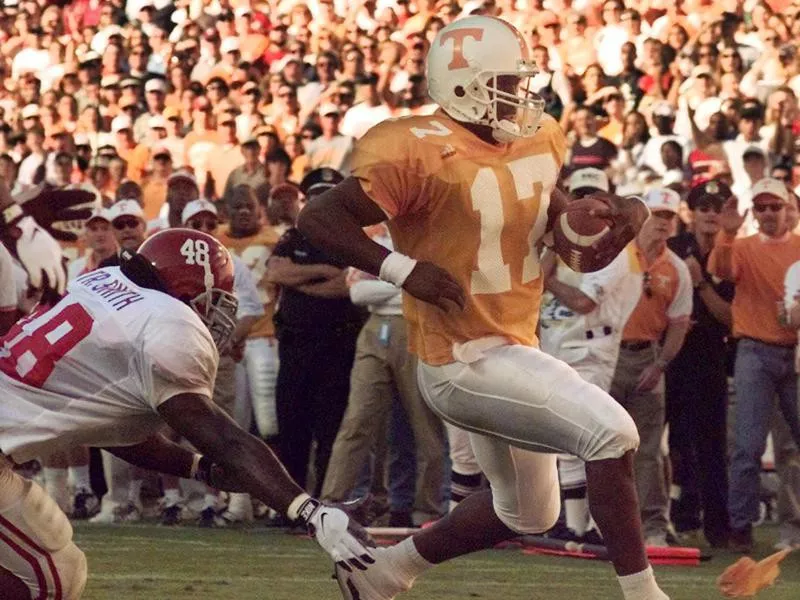
Tennessee quarterback Tee Martin scores a touchdown against Alabama in 1998. Mark Humphrey / AP Photo
Record: 13-0
Finish: Beat No. 2 Florida State 23-16 in the Fiesta Bowl (BCS Championship Game)
Final ranking: No. 1 (AP, FWAA, NFF)
Key stats: These Vols rode a balanced offense and stout defense to an unbeaten season. Quarterback Tee Martin passed for 19 touchdowns, while backs Travis Henry, Jamal Lewis and Travis Stephens ran for 450-plus yards apiece. Meanwhile, the defense gave up 14.5 points per game, eighth fewest in the country.
Head coach: Phillip Fullmer
Notable players: Henry, Martin, wide receiver Peerless Price, linebacker Al Wilson
Bottom line: Some jealous hearts called this team lucky. We call it clutch.
True, these Vols didn’t blow many teams away — they had wins of one, three, four, seven and eight points — but they made too many big plays in big moments to be considered flukes.
Oh, they also had a 6-0 record against ranked teams.
29. 2010 Auburn Tigers
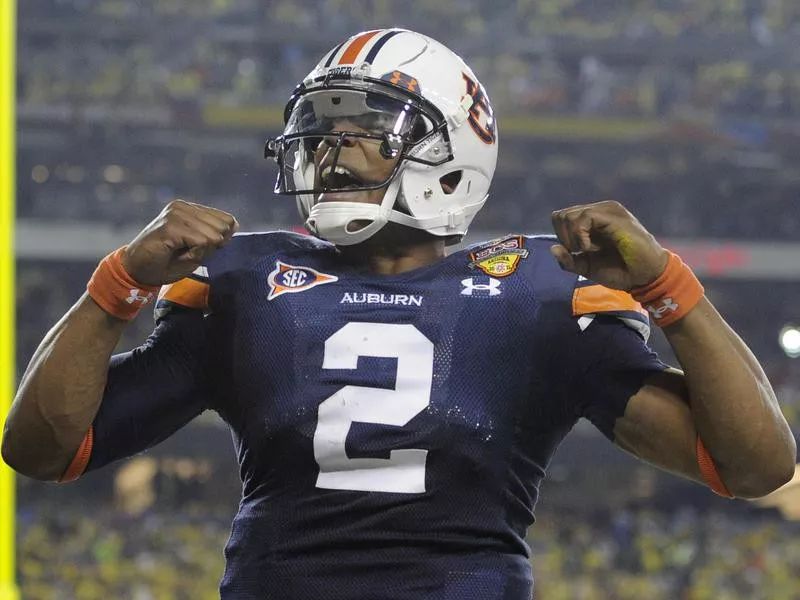
Auburn quarterback Cam Newton celebrates after a touchdown against Oregon in the 2011 BCS Championship Game. Mark J. Terrill / AP Photo
Record: 14-0
Finish: Beat No. 2 Oregon 22-19 in the BCS Championship Game
Final ranking: No. 1 (AP, FWAA, NFF)
Key stats: Their defense allowed an average of 24.1 points per game, which ranked 53rd in the country. Because the offense put up 40 points or more nine times, it had plenty of margin for error most games.
Head coach: Gene Chizik
Notable players: Quarterback Cam Newton, wide receiver Darvin Adams, defensive lineman Nick Fairley, offensive lineman Lee Ziemba
Bottom line: Know the big bully who tweaked noses on the playground? That was Cam Newton as a junior.
The quarterback had a hand in no fewer than 51 touchdowns — 20 on the ground and 31 in the air — one of them as a receiver, no less.
Then, the Heisman Trophy winner took a pay cut to play on Sundays, Mondays and Thursdays.
28. 1981 Clemson Tigers
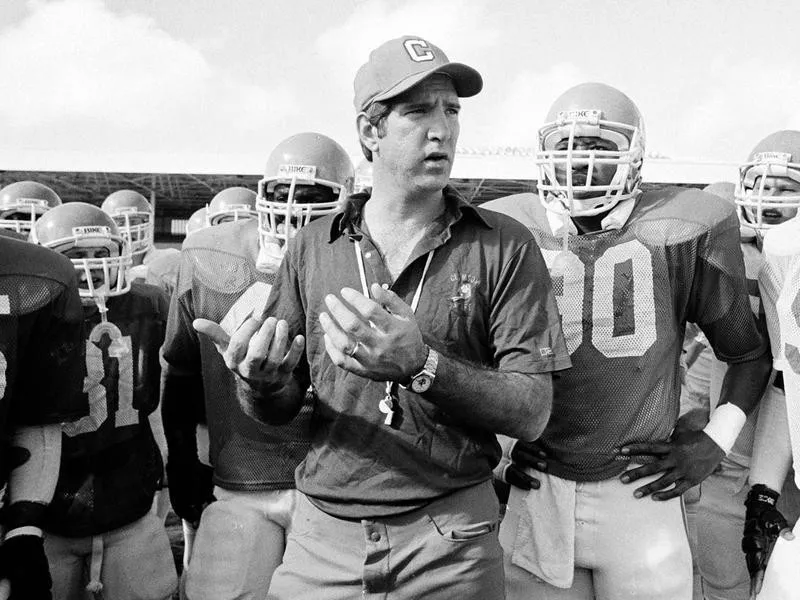
Clemson football coach Danny Ford instructs his team as they warm up for the 1982 Orange Bowl against Nebraska. Kathy Willens / AP Photo
Record: 10-1
Finish: Beat No. 4 Nebraska 22-15 in the Orange Bowl
Final ranking: No. 1 (AP, FWAA, NFF, UPI)
Key stats: Their success formula was a simple one — control the ball on the ground then get the h-e-double-uprights out of the way. The defense allowed one touchdown in the first five games and more than 10 points only three times all season.
Head coach: Danny Ford
Notable players: Tailback Cliff Austin, linebacker Jeff Davis, safety Terry Kinard, wide receiver/kickoff returner Perry Tuttle
27. 1958 Louisiana State Tigers
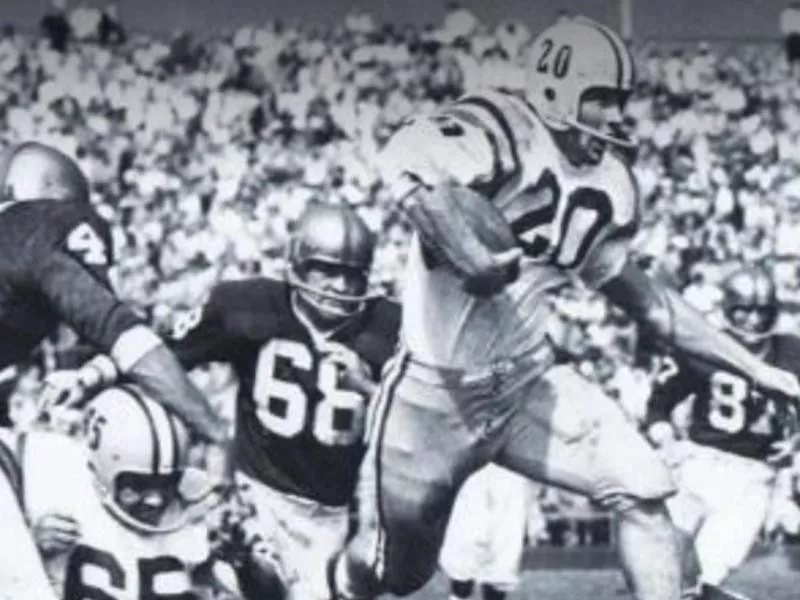
Billy Cannon rushed for 686 yards and 10 touchdowns for LSU in 1958. Bengals and Bandits / Facebook
Record: 11-0
Finish: Beat No. 12 Clemson 7-0 in the Sugar Bowl
Final ranking: No. 1 (AP, UPI)
Key stats: Baton Rougers still talk about the legendary Billy Cannon punt return that beat third-ranked Ole Miss on Halloween night in 1959 liked it happened yesterday. Ten months earlier, the halfback/punt returner/placekicker/punter was named Sugar Bowl Most Valuable Player, a fitting conclusion to the greatest season in school history.
Head coach: Paul Dietzel
Notable players: Cannon, offensive/defensive end Mel Branch, center Max Fugler, quarterback/safety Warren Rabb
26. 1955 Oklahoma Sooners
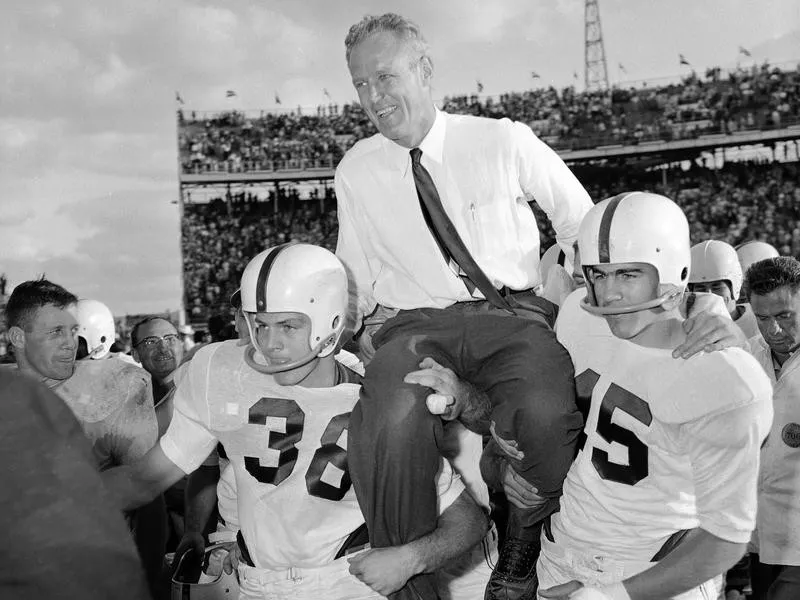
Oklahoma coach Bud Wilkinson gets a victory ride after winning the 1956 Orange Bowl in Miami, Florida. Earl Shugars / AP Photo
Record: 11-0
Finish: Beat No. 3 Maryland 20-6 in the Orange Bowl
Final ranking: No. 1 (AP, FWAA, UP)
Key stats: The Sooners ranked first in points scored (35.0 per game) and second in fewest points allowed (5.5) in the country.
Head coach: Bud Wilkinson
Notable players: Quarterback/defensive back Jimmy Harris, offensive/defensive halfback/kick returner Tommy McDonald, offensive/defensive halfback Clendon Thomas, center/linebacker Jerry Tubbs
25. 1968 Ohio State Buckeyes
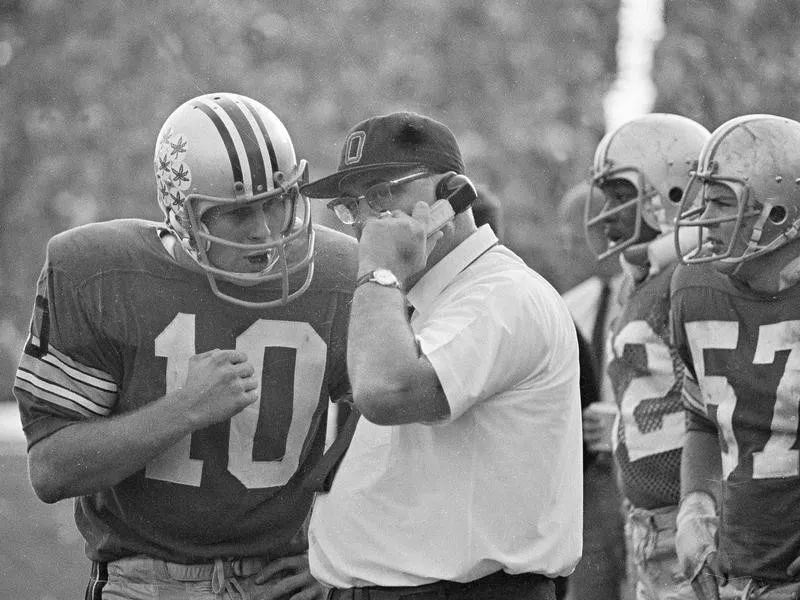
Ohio State quarterback Rex Kern and coach Woody Hayes confer during a game against Michigan in 1968. AP Photo
Record: 10-0
Finish: Beat No. 2 Southern California 27-16 in the Rose Bowl
Final ranking: No. 1 (AP, FWAA, NFF, UPI)
Key stats: Three yards and a cloud of dust? No, this offense was more like 4 1/2 yards and a forearm shiver to the chin. The vaunted Buckeyes ground game averaged 301.8 yards and 3.4 touchdowns per game. Bruiser Jim Otis led the way with 985 and 17, respectively.
Head coach: Woody Hayes
Notable players: Otis, quarterback Rex Kern, middle guard Jim Stillwagon, defensive back Jack Tatum
24. 1987 Miami Hurricanes
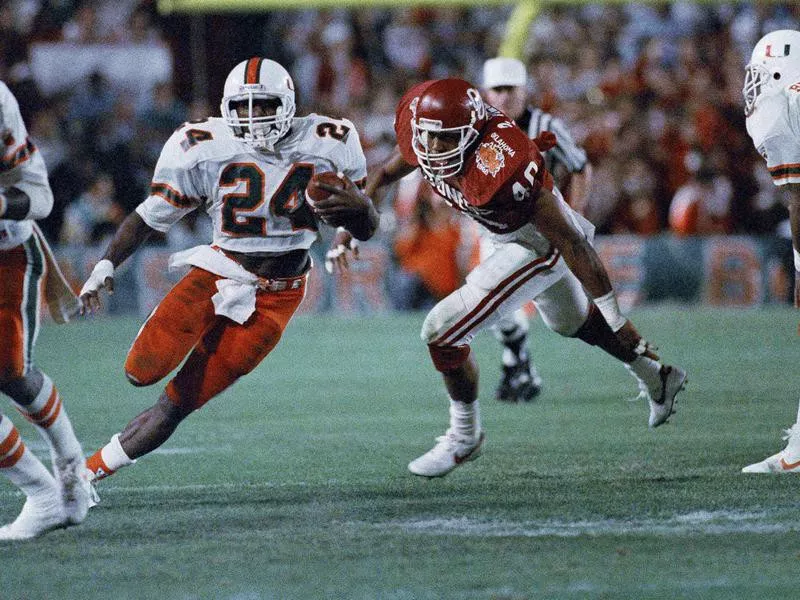
Miami’s Warren Williams runs through an opening against Oklahoma in the 1988 Orange Bowl. Chris O’Meara / AP Photo
Record: 12-0
Finish: Beat No. 1 Oklahoma 20-14 in the Orange Bowl
Final ranking: No. 1 (AP, FWAA, NFF, UPI)
Key stats: In terms of speed and quickness, there was no better defense of its time. Opponents managed only 244.0 total yards and 1.0 touchdowns per game.
Head coach: Jimmy Johnson
Notable players: Safety Bennie Blades, wide receiver Michael Irvin, defensive lineman Daniel Stubbs, quarterback Steve Walsh
23. 1976 Pitt Panthers
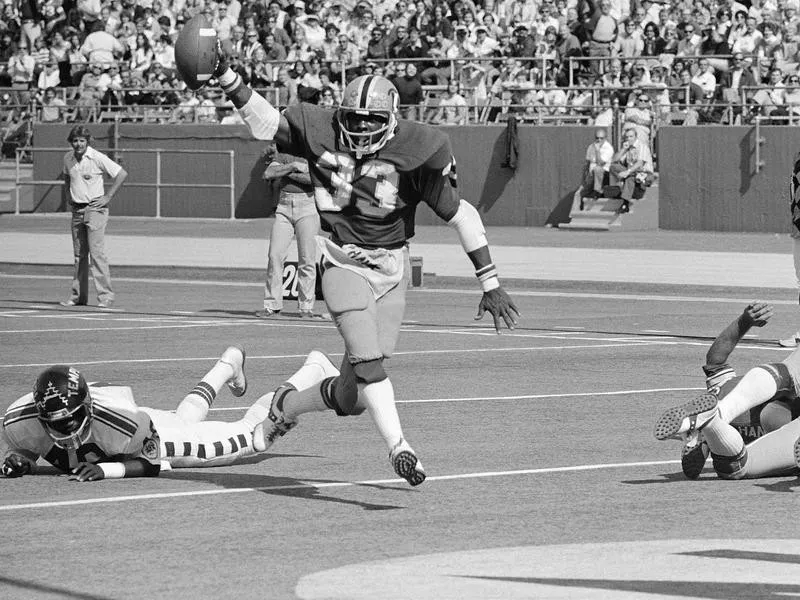
Tony Dorsett scores on a 2-point conversion against Temple in 1976. AP Photo
Record: 12-0
Finish: Beat No. 5 Georgia 27-3 in the Sugar Bowl
Final ranking: No. 1 (AP, FWAA, NFF, UPI)
Key stats: Senior tailback Tony Dorsett (2,217 yards from scrimmage, 23 touchdowns) played the Road Runner to the opponents’ Wile E. Coyote. So impressed were Navy cadets that, when T.D. broke Archie Griffin’s rushing record in Annapolis, they gave him a standing ovation and six-gun salute.
Head coach: Johnny Majors
Notable players: Dorsett, quarterback Matt Cavanaugh, safety Bob Jury, middle guard Al Romano
22. 1982 Penn State Nittany Lions

Penn State quarterback Todd Blackledge signals No. 1 after beating Georgia in the 1983 Sugar Bowl to claim the national championship. AP Photo
Record: 11-1
Finish: Beat No. 1 Georgia 27-23 in the Sugar Bowl
Final ranking: No. 1 (AP, FWAA, NFF, UPI)
Key stats: Never had a coach Joe Paterno team boasted this much depth of talent at the so-called skill positions. An offense that featured five future NFL players averaged 207.5 yards on the ground and 215.4 in the air per game. Only four teams averaged more points (32.9) in the country.
Head coach: Paterno
Notable players: Quarterback Todd Blackledge, wide receiver Kenny Jackson, linebacker Scott Radecic, tailback Curt Warner
21. 1969 Texas Longhorns
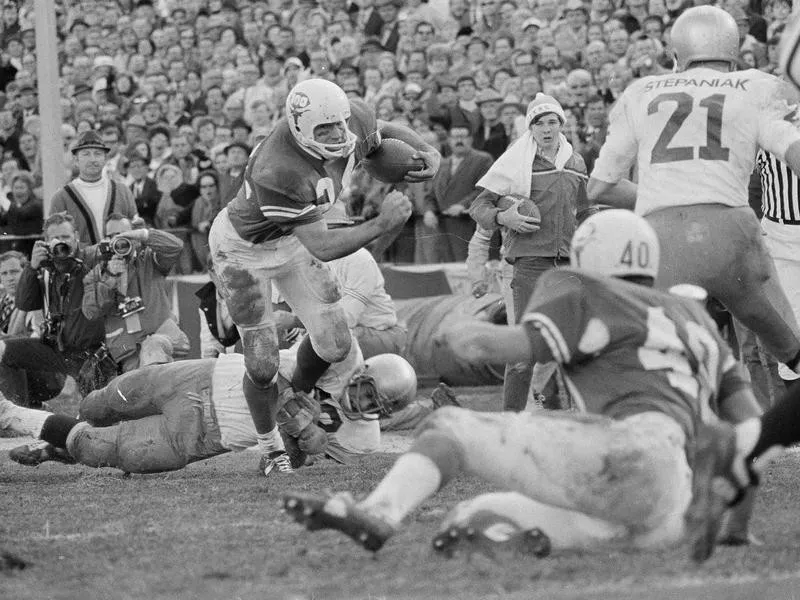
Texas halfback Ted Koy heads for a score against Notre Dame in the 1970 Cotton Bowl. AP Photo
Record: 11-0
Finish: Beat No. 9 Notre Dame 21-17 in the Cotton Bowl
Final ranking: No. 1 (AP, FWAA, NFF, UPI)
Key stats: One year after head coach Darrell Royal and assistant Emory Ballard unveiled the wishbone offense, the three-back, triple-option scheme took off. The Longhorns outgained their overwhelmed opponents by a crazy 4-to-1 margin (363.0-90.0 per game) on the ground.
Head coach: Royal
Notable players: Defensive lineman Bill Atessis, halfback Jim Bertelsen, offensive tackle Bob McKay, quarterback James Street
20. 1959 Syracuse Orangemen
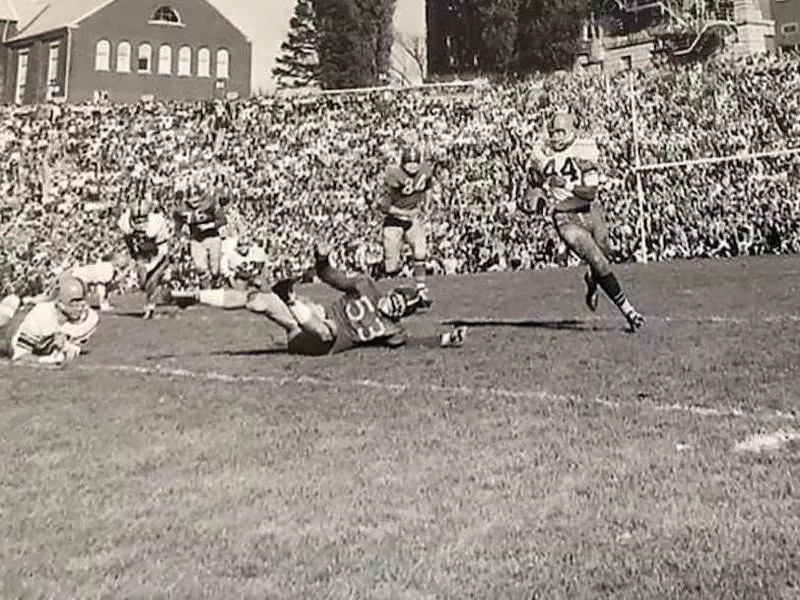
Syracuse halfback Ernie Davis during a game at Archbold Stadium in 1959. Walter Miller?/Nostalgic Syracuse / Facebook
Record: 11-0
Finish: Beat No. 4 Texas 23-14 in the Cotton Bowl
Final ranking: No. 1 (AP, FWAA, NFF, UPI)
Key stats: Orangemen led the NCAA in scoring offense (39.0 points per game), total offense (451.5 yards per game), rushing yards per game (313.6), pass completion percentage (.581), touchdown passes (21), total defense (96.2 yards per game) and rushing defense (19.3 yard per game).
Head coach: Ben Schwartzwalder
Notable players: Halfback Ernie Davis, guard Roger Davis, offensive/defensive end Fred Mautino, offensive tackle/placekicker Bob Yates
19. 2013 Florida State
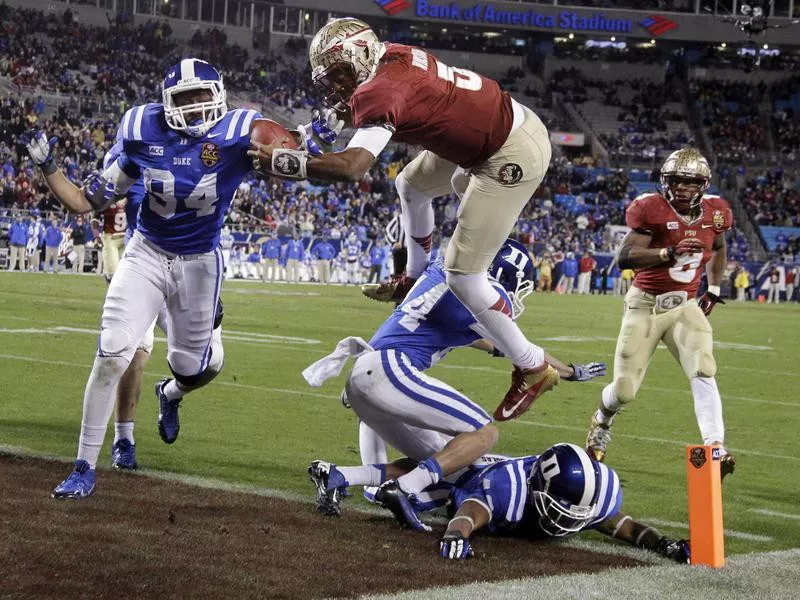
Florida State quarterback Jameis Winston scores a touchdown against Duke in 2013. Bob Leverone / AP Photo
Record: 14-0
Finish: Beat No. 2 Auburn 34-31 in the BCS championship game
Final ranking: No. 1 (AP, FWAA, NFF)
Key stats: Was this offense the greatest collection of athletic talent on one side of the field in college football history? Could be. It amassed 51.6 points and 519.1 yards per game and scored at least 34 points against each of five ranked opponents.
Head coach: Jimbo Fisher
Notable players: Tailback Devonta Freeman, defensive back Lemarcus Joyner, offensive lineman Bryan Stork, quarterback Jameis Winston
18. 1996 Florida Gators

Florida running back Fred Taylor dives for a touchdown against Florida State in the 1997 Sugar Bowl at the Superdome in New Orleans. John Bazemore / AP Photo
Record: 12-1
Finish: Beat No. 1 Florida State 52-20 in the Sugar Bowl
Final ranking: No. 1 (AP, FWAA, NFF)
Key stats: Danny Wuerffel passed for 3,625 yards and 39 touchdowns in a Heisman Trophy season. Then again, the quarterback had more options than a Denny’s menu. Six guys played key roles at the other skill positions with an offense that lit up scoreboards for an NCAA-high 47.0 points per game.
Head coach: Steve Spurrier
Notable players: Wuerffel, wide receiver/kickoff returner Ike Hilliard, wide receiver/kick returner Anthony Reidel, safety Lawrence Wright
16. 1993 Florida State Seminoles
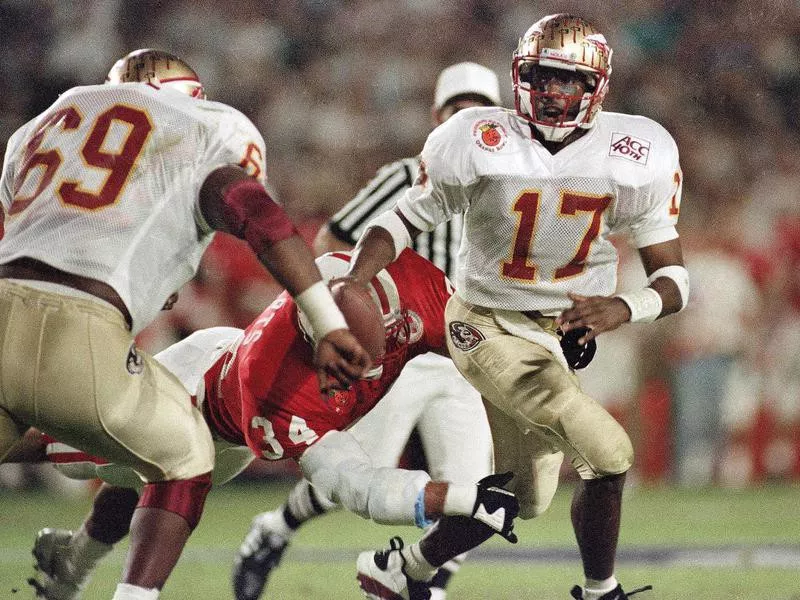
Florida State quarterback Charlie Ward scrambles against Nebraska during the 1994 Orange Bowl. Doug Mills / AP Photo
Record: 12-1
Finish: Beat No. 2 Nebraska 18-16 in the Orange Bowl
Final ranking: No. 1 (AP, FWAA, UPI)
Key stats: Senior quarterback Charlie Ward ran the so-called “Fast Break” attack much like the point guard he was with the Noles’ basketball team. The Heisman Trophy winner accounted for 259.3 yards from scrimmage per game in an offense that put up 40-or-more points eight times.
Head coach: Bobby Bowden
Notable players: Ward, linebacker Derrick Brooks, wide receiver Kez McCorvey, cornerback/punt returner Corey Sawyer
15. 2005 Texas Longhorns
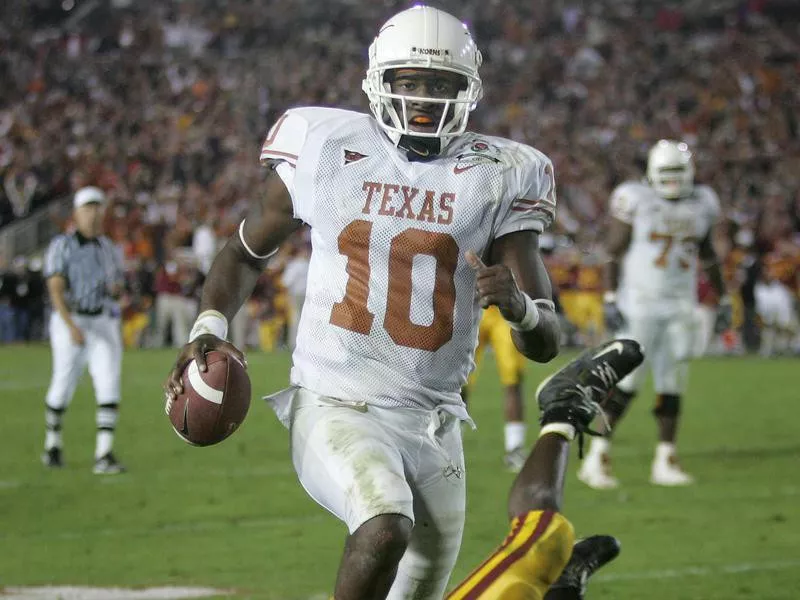
Texas quarterback Vince Young rushes for the game-winning touchdown against USC in the 2006 Rose Bowl. Paul Sakuma / AP Photo
Record: 13-0
Finish: Beat No. 1 Southern Cal 41-38 in the Rose Bowl (BCS title game)
Final ranking: No. 1 (AP, FWAA, NFF)
Key stats: So defense wins championships, huh? These were among the more one-dimensional national champions of recent vintage, but oh, what a dimension it was. The offense piled up 40-plus points in each of the final 11 games. Four players rushed for 10 touchdowns or more.
Head coach: Mac Brown
Notable players: Running back Jamaal Charles, offensive lineman Jonathan Scott, safety Michael Huff, quarterback Vince Young
14. 2019 Louisiana State Tigers
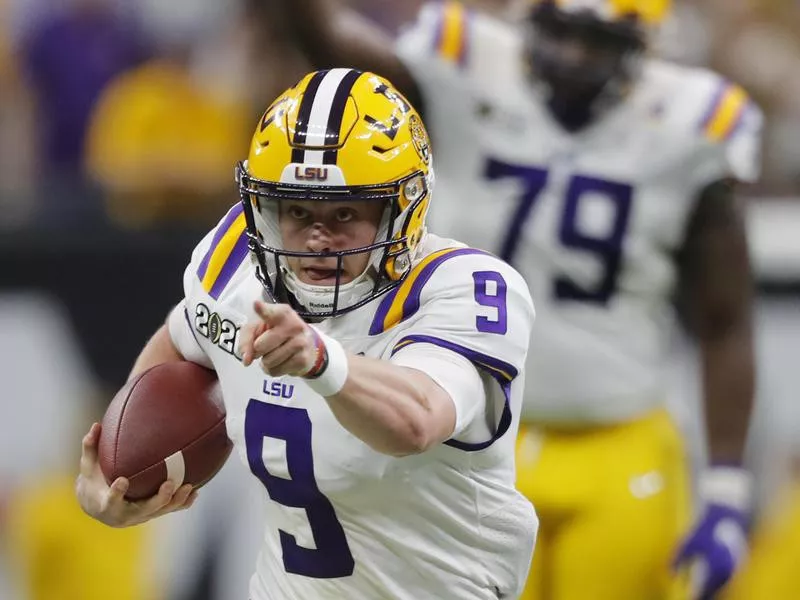
LSU quarterback Joe Burrow runs against Clemson during the Tigers’ national championship win against Clemson. Gerald Herbert / AP Photo
Record: 15-0
Finish: Beat Clemson 42-25 in the BCS championship game
Final ranking: No. 1 (AP, FWPPA/National Football Foundation polls)
Key stats: Transfer quarterback Joe Burrow captured the Heisman Trophy on the strength of a 76.3 pass completion rate, 5,671 yards and 60 touchdowns in 60 quarters. The explosive offense rolled up at least 36 points in all except one game.
Head coach: Ed Orgeron
Notable players: Burrow, wide receiver J’Marr Chase, safety Grant Delpit, cornerback Derek Stingley Jr.
13. 1978 Alabama Crimson Tide
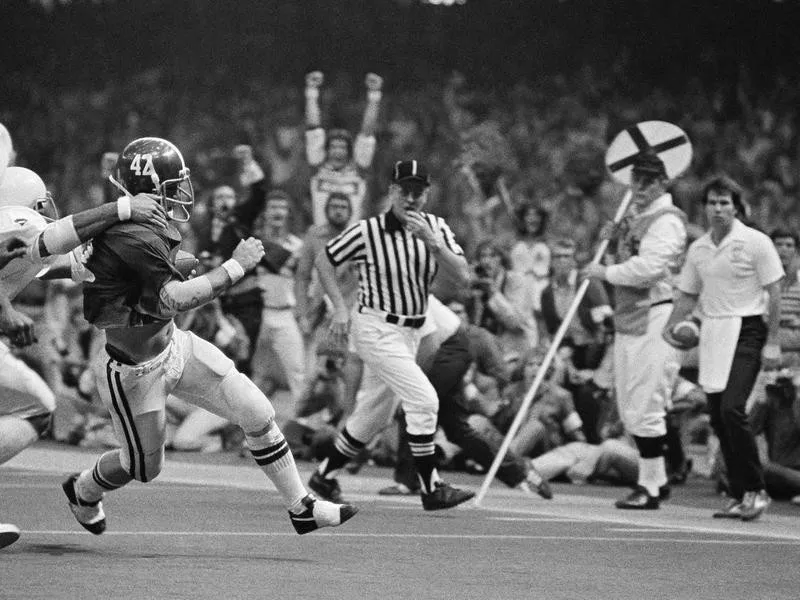
Alabama’s Major Ogilvie heads for the end zone against Penn State in the 1979 Sugar Bowl. AP Photo
Record: 11-1
Finish: Beat No. 1 Penn State 14-7 in the Sugar Bowl
Final ranking: No. 1 (AP, FWAA, NFF)
Key stats: What this Bama team had was strength in numbers, especially in the backfield, where a bevy of backs moved the ball consistently and wore down defenses in the process. A half-dozen players ran for a minimum of 200 yards and 4.6 per carry.
Head coach: Paul (Bear) Bryant
Notable players: Linebacker Barry Krauss, halfback/kick returner Tony Nathan, defensive lineman Marty Lyons, quarterback Jeff Rutledge
11. 2008 Florida Gators

Florida quarterback Tim Tebow throws a pass against Oklahoma in the 2009 BCS Championship Game. Mark Humphrey / AP Photo
Record: 13-1
Finish: Beat No. 2 Oklahoma 24-14 in the BCS championship game
Final ranking: No. 1 (AP, FWAA, NFF)
Key stats: In a Heisman Trophy performance, quarterback Tim Tebow accounted for 55 percent of the offense with 673 yards on the ground, 2,746 in the air. Yet what set this team apart was an unusual balance — it ranked fourth in points scored (43.6) and fewest points allowed (12.9) in the country.
Head coach: Urban Meyer
Notable players: Tebow, defensive lineman Carlos Dunlap, running back/wide receiver Percy Harvin, cornerback Joe Haden
10. 1952 Michigan State Spartans
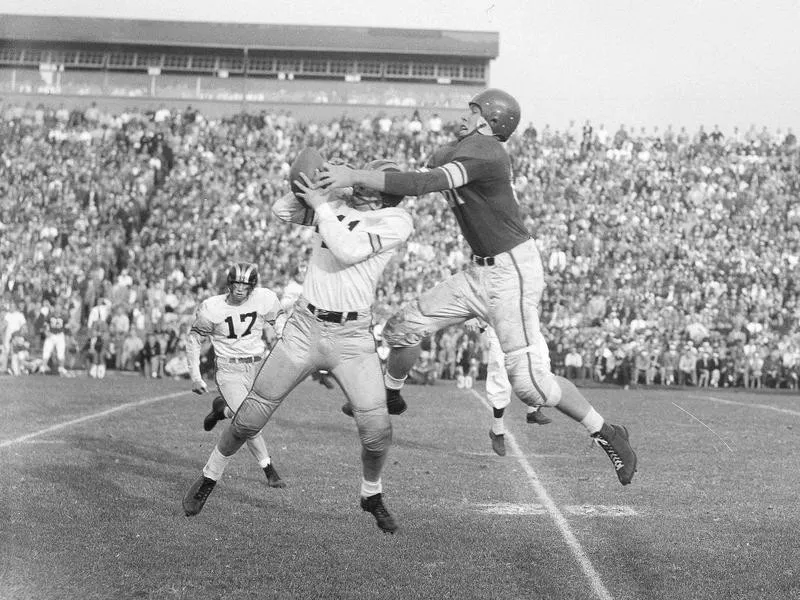
Michigan end Paul Dekker, right, fights for the ball against Purdue in 1952. AP Photo
Record: 9-0
Finish: Beat Marquette 62-13 in the regular-season finale
Final ranking: No. 1 (AP, UP)
Key stats: Hey, look, a 1950s team with a big-play pass offense! Sparty averaged 8.8 yards per attempt through the air. They also had a ground game — four regulars averaged 5.0-plus yards per carry.
Head coach: Clarence “Biggie” Munn
Notable players: Offensive/defensive end Paul Dekker, quarterback/safety Tom Yewcic, offensive/defensive halfbacks Don McAuliffe and Billy Wells
9. 2004 Southern California Trojans
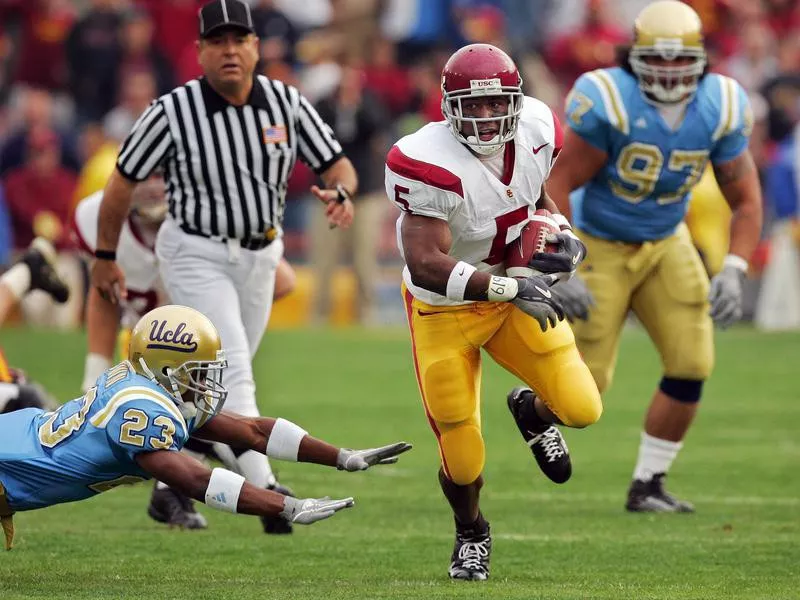
Reggie Bush runs for a touchdown on a pass play against UCLA in 2004. Mark J. Terrill
Record: 13-0
Finish: Beat No. 2 Oklahoma 59-16 in the Orange Bowl
Final ranking: No. 1 (AP, FWAA, NFF)
Key stats: For sheer entertainment value, there was none better. This ridiculously talented bunch won by an average margin of 25 points per game.
Head coach: Pete Carroll
Notable players: Tailback/kick returner Reggie Bush, defensive linemen Shaun Cody, quarterback Matt Leinert, tailback Lendale White
8. 2001 Miami Hurricanes
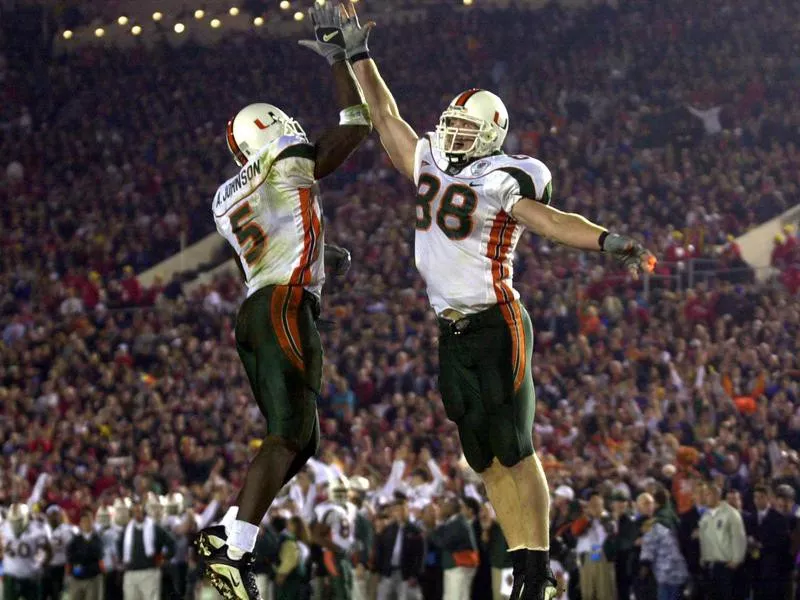
Andre Johnson and Jeremy Shockey celebrate a touchdown against Nebraska during the 2002 Rose Bowl. Paul Sakuma / AP Photo
Record: 11-0
Finish: Beat No. 4 Nebraska 37-14 in the Rose Bowl (BCS championship game)
Final ranking: No. 1 (AP, FWAA, NFF)
Key stats: In true ‘Canes tradition, the defense was equal parts athletic skill and loudmouth swag. It averaged 9.8 points and 9.9 accepted penalties per game.
Head coach: Larry Coker
Notable players: Quarterback Ken Dorsey, offensive tackle Bryan McKinnie, running back Clinton Portis, safety Ed Reed
Bottom Line: 2001 Miami Hurricanes
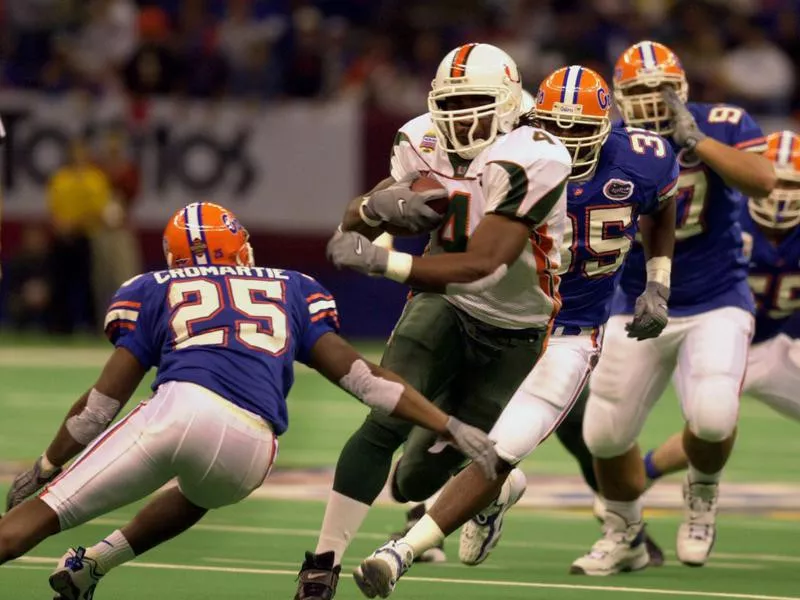
The 2001 Miami Hurricanes could have beaten some NFL teams. Stefan Savoia / AP Photo
Larry Coker didn’t inherit just a highly motivated contender that the BCS computers had snubbed the previous season. More like a future NFL team.
Ken Dorsey (Maxwell) and Bryan McKinnie (Outland) won major awards, Ed Reed was a consensus All-America and Phillip Buchanon, Joaquin Gonzalez and Jeremy Shockey also received All-America mention.
That doesn’t include Frank Gore, Andre Johnson, Willis McGahee, Antrel Rolle, Jonathan Vilma, Vince Wilfork.
7. 2018 Clemson Tigers
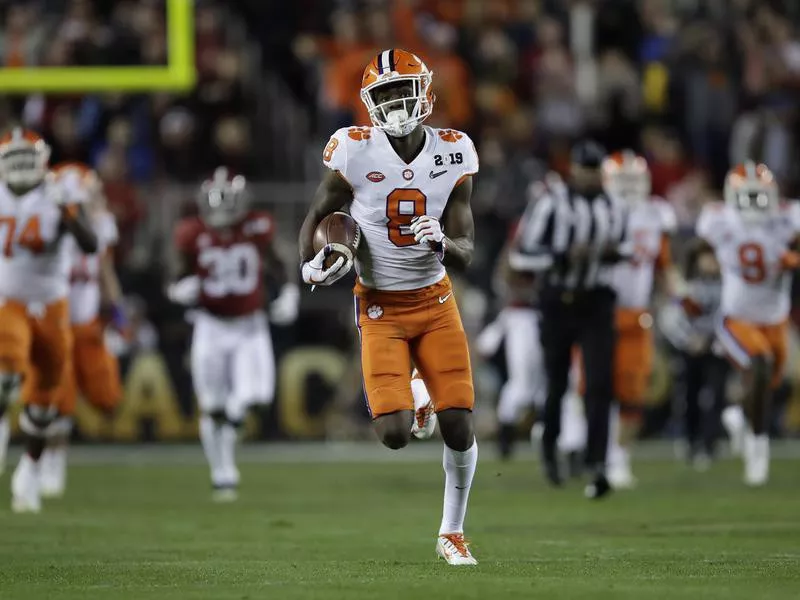
Clemson’s Justyn Ross catches a touchdown pass against Alabama in the 2019 College Football Playoff championship game at Levi’s Stadium in Santa Clara, California. Ben Margot / AP Photo
Record: 15-0
Finish: Beat No. 1 Alabama 44-16 in the CFP championship game
Final ranking: No. 1 (AP, FWAA/NFF)
Key stats: These Tigers dominated in all phases of the game. They ranked first in fewest points allowed (13.1) and fourth in points scored (44.3) in the country.
Head coach: Dabo Swinney
Notable players: Running back Travis Etienne, linebacker Clelin Farrell, offensive lineman Mitch Hyatt, quarterback Trevor Lawrence
Bottom line: After close calls against Texas A&M and Syracuse in the first five games, Trevor Lawrence assumed the reins, and his team took off.
It peaked with three blowouts by a combined 116-29 score in the postseason.
6. 1974 Oklahoma Sooners
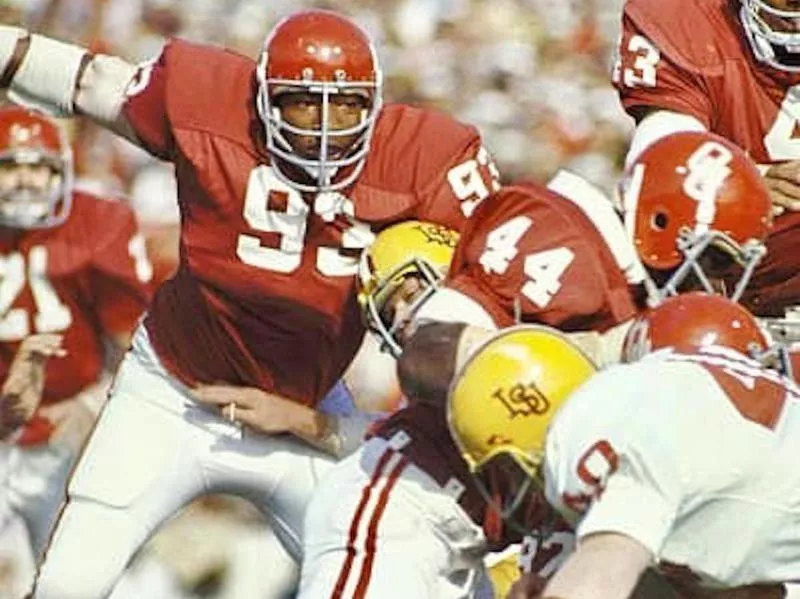
Lee Roy Selmon was a beast for Oklahoma in 1974. The Sports Time Machine / Facebook
Record: 11-0
Finish: Beat unranked Oklahoma State 44-17 in the regular-season finale
Final ranking: No. 1 (AP)
Key stats: The defense didn’t allow more than 14 points in any game, while the vaunted wishbone attack failed to produce at least 28 points only once.
Head coach: Barry Switzer
Notable players: Defensive lineman Lee Roy Selmon, linebacker Rod Shoate, offensive lineman John Roush, tailback Joe Washington
Head coach: Barry Switzer
5. 1948 Michigan Wolverines
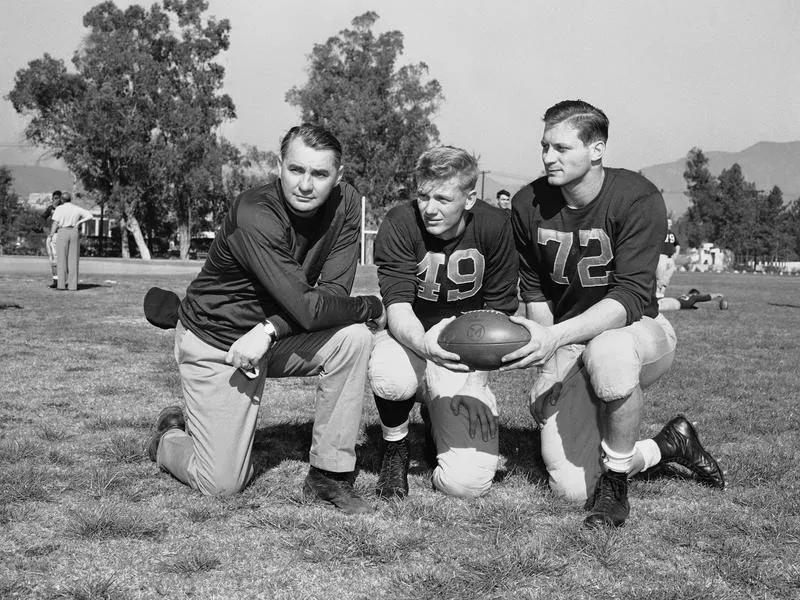
Michigan coach Bennie Oosterbaan, left, with halfback Chuck Ortmann, center, and Al Wahl in Pasadena, California, at the Rose Bowl in 1950. Harold Filan / AP Photo
Record: 9-0
Finish: Beat No. 13 Ohio State 13-3 in the regular-season finale
Final ranking: No. 1 (AP)
Key stats: You want defense? OK, We got your defense right here: The Wolverines allowed six touchdowns in 36 quarters. They blanked Oregon, No. 15 Purdue and No. 3 Northwestern in consecutive weeks.
Head coach: Bennie Oosterbaan
Notable players: Quarterback Pete Elliott, offensive/defensive end Dick Rifenburg, offensive/defensive linemen Domini Tomasi and Al Wistert
4. 1972 Southern California Trojans
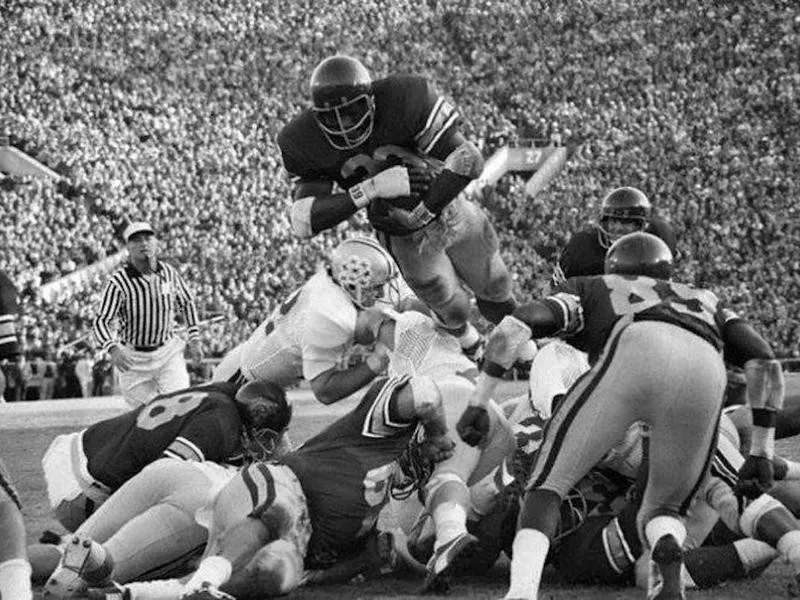
USC running back Sam Cunningham scores a touchdown against Ohio State in the 1973 Rose Bowl game. Rose Bowl Game / Facebook
Record: 12-0
Finish: Beat No. 2 Ohio State 42-17 in the Rose Bowl
Final ranking: No. 1 (AP, FWAA, NFF, UPI)
Key stats: The Trojans waxed six ranked teams by an average 34-7 score. Only a 30-21 victory at No. 15 Stanford was by single figures.
Head coach: John McKay
Notable players: Tailback/kickoff returner Anthony Davis, split end Lynn Swann, linebacker Richard Wood, tight end Charles Young
2. 1946 Notre Dame Fighting Irish
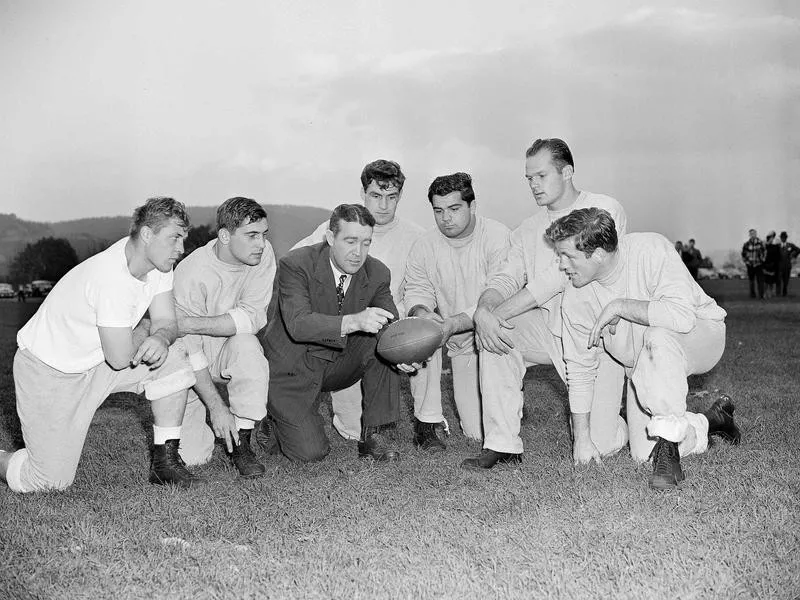
Notre Dame coach Frank Leahy, center, in 1946 at Bear Mountain, New York, with players, left to right, center George Strohmeyer, quarterback Johnny Lujack, guard Bob McBridge, right tackle Zigmont Czarobski, halfback Floyd Simmons and halfback Terence Brennan. They are preparing for a game against Army at Yankee Stadium. John Lindsay / AP Photo
Record: 8-0-1
Finish: Beat No. 16 USC 26-6 in the regular-season finale
Final ranking: No. 1 (AP)
Key stats: The arrival of Outland Trophy winner George Connor from Holy Cross made this defense historically great. It allowed 120.0 yards from scrimmage and 2.7 points per game.
Head coach: Frank Leahy
Notable players: Connor, offensive/defensive halfback Terry Brennan, quarterback/safety Johnny Lujack, offensive/defensive lineman George Strohmeyer
Bottom Line: 1945 Army Black Knights

The 1945 Army Black Knights were unbeatable. SteenoKyle / Twitter
What’s our case for these Black Knights as the best of post-war era, if not all time?
Start with the indomitable “Mr. Inside” (Doc Blanchard) and Mr. Outside (Glenn Davis), the kind of dual star power that came along once in a lifetime. Furthermore, liberal post-war transfer rules allowed the driven Blaik to recruit his own All-America team.
Let’s also not forget that, as repeat national champions, the core of this Army team already had been through the wars, one might say.
It laid waste to five ranked opponents — including No. 2 Notre Dame (48-0) and No. 6 Penn (61-0) — after which Blanchard was awarded the Heisman Trophy in a two-man race. Davis would get his turn one year later.